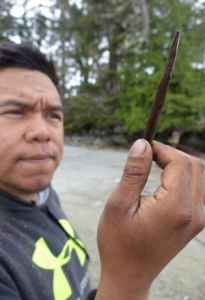Estimated Reading time

2 Mins
Long-time Home: Heiltsuk Nation Village Site Far Pre-dates Pyramids

New research from the Hakai Institute confirms the village site of the Heiltsuk First Nation was occupied by humans as early as 14,000 years ago, which makes it among the oldest of human settlements in North America. According to PhD student Alisha Gavreau, who presented her findings this week at the annual meeting of the Society for American Archeology being held in Vancouver, analysis of ancient food waste and charcoal from a hearth found 2.5 metres deep at the Heiltsuk Nation’s Triquet Island site also suggests significant changes in local diets over time—for example, from hunting and eating seals and sea lions for about 7,000 years, to trapping finfish and cultivating shellfish. Artifacts found on the site include a wooden projectile-launching device called an atlatl, compound fish hooks, and a hand drill for starting fires. Archeological evidence suggests the village survived two tsunamis more than 1,000 years apart—the latest of which was about 5,600 years ago.
Read more about this fascinating new research on CBC News (includes audio of an interview with the Hakai Institute PhD researcher Alisha Gavreau), and in the Vancouver Sun.
The Heiltsuk Nation’s ongoing leadership in herring stock recovery in its Central Coast territory is explored in this recent story in Coast Funds’ free newsletter, the Talking Stick. You can subscribe here to the Talking Stick for more inspiring stories about work by First Nations in conservation and economic development in the Great Bear Rainforest.
